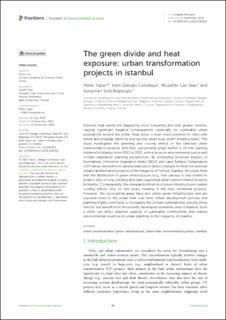| dc.contributor.author | Yazar, Mahir | |
| dc.contributor.author | Cetinkaya, Irem Daloglu | |
| dc.contributor.author | Iban, Muzaffer Can | |
| dc.contributor.author | Bilgilioglu, Suleyman Sefa | |
| dc.date.accessioned | 2024-04-19T13:31:32Z | |
| dc.date.available | 2024-04-19T13:31:32Z | |
| dc.date.created | 2023-11-23T09:07:34Z | |
| dc.date.issued | 2023-11-23 | |
| dc.identifier.issn | 2296-665X | |
| dc.identifier.uri | https://hdl.handle.net/11250/3127465 | |
| dc.description.abstract | Extreme heat events are happening more frequently and with greater severity, causing significant negative consequences, especially for vulnerable urban populations around the globe. Heat stress is even more common in cities with dense and irregular planning and lacking urban blue-green infrastructures. This study investigates the greening and cooling effects of five selected urban transformation projects and their surrounding areas (within a 10-min walking distance) in Istanbul from 2013 to 2021, with a focus on environmental justice and climate adaptation planning perspectives. By employing temporal analysis of Normalized Difference Vegetation Index (NDVI) and Land Surface Temperature (LST) values derived from Landsat data sets to detect changes in these five selected urban transformation projects in the megacity of Türkiye, Istanbul, this study finds that the distribution of green infrastructures (e.g., tree canopy) is only limited to project sites of long-running and state-supported urban transformation projects in Istanbul. Consequently, the unequal distribution of green infrastructures creates cooling effects only for the locals residing in the new residential projects. However, the surrounding areas have less urban green infrastructure and are exposed more to the urban heat over time. Urban development policies and planning highly contribute to increasing the climate vulnerabilities among those who do not benefit from the recently developed residential units in Istanbul. Such a trend can affect adaptive capacity of vulnerable communities and redress environmental injustices in urban planning in the megacity of Istanbul. | en_US |
| dc.language.iso | eng | en_US |
| dc.publisher | Frontiers | en_US |
| dc.rights | Navngivelse 4.0 Internasjonal | * |
| dc.rights.uri | http://creativecommons.org/licenses/by/4.0/deed.no | * |
| dc.title | The green divide and heat exposure: urban transformation projects in Istanbul | en_US |
| dc.type | Journal article | en_US |
| dc.type | Peer reviewed | en_US |
| dc.description.version | publishedVersion | en_US |
| dc.rights.holder | Copyright 2023 the authors | en_US |
| dc.source.articlenumber | 1265332 | en_US |
| cristin.ispublished | true | |
| cristin.fulltext | original | |
| cristin.qualitycode | 1 | |
| dc.identifier.doi | https://doi.org/10.3389/fenvs.2023.1265332 | |
| dc.identifier.cristin | 2200668 | |
| dc.source.journal | Frontiers in Environmental Science | en_US |
| dc.identifier.citation | Frontiers in Environmental Science. 2023, 11, 1265332. | en_US |
| dc.source.volume | 11 | en_US |

